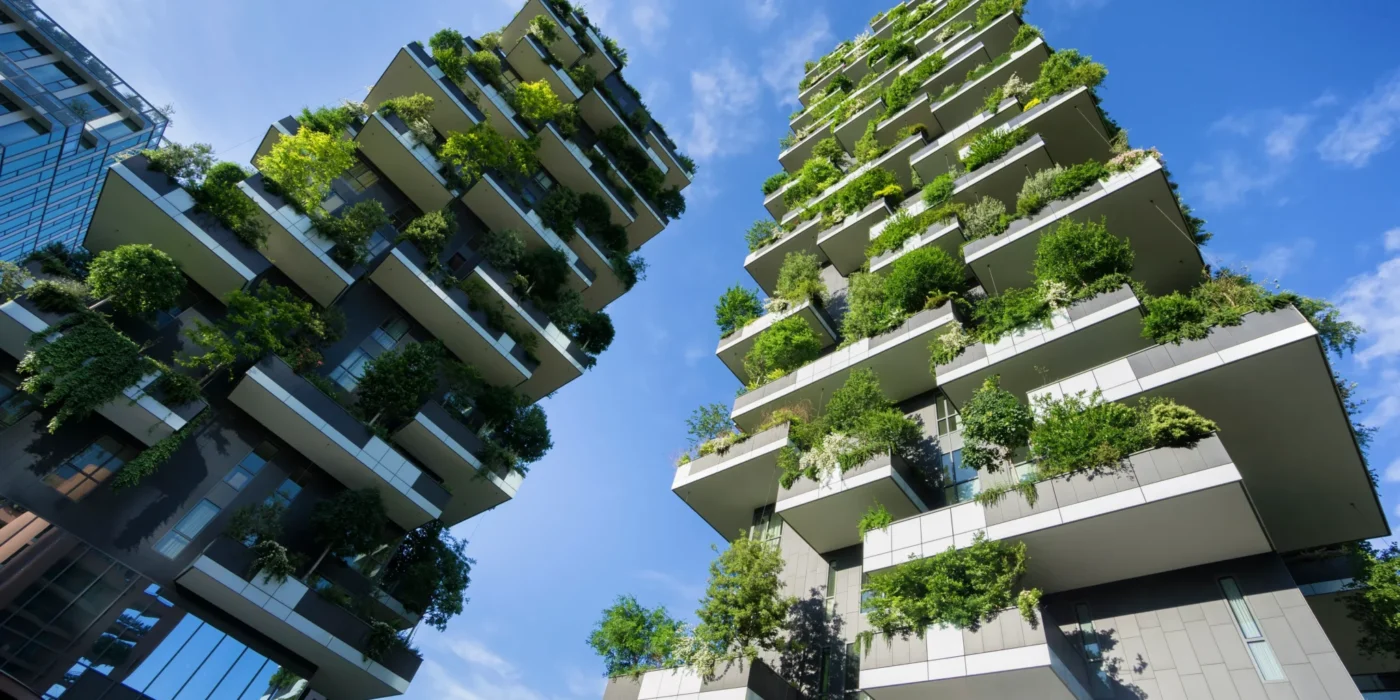Picture a building that breathes with nature, where sunlight brightens every corner, fresh air flows easily, and the monthly bills stay low. This is the idea behind green buildings.
A green building is not just about walls and roofs. It is designed to save energy, cut water waste, and create healthier spaces for people. Simple features like efficient lights, water recycling, eco-friendly materials, and wide windows make a big difference.
In a time when climate change and high costs affect us all, green buildings offer hope. They lower expenses, improve health, and protect the environment. Around the world, businesses, governments, and homeowners are moving toward this smarter way of building. This is why all around the world green architecture high rise building construction is getting really popular.
In this blog, we’ll walk through what green buildings are, how they started, their key features, inspiring examples, and the future of sustainable design.
What Is a Green Building?
A green building is a structure that is designed, built, and operated in a way that reduces its impact on the environment while improving the quality of life for the people inside it. The main idea is to use resources like energy, water, and materials more efficiently, while also creating healthier and more comfortable indoor spaces.
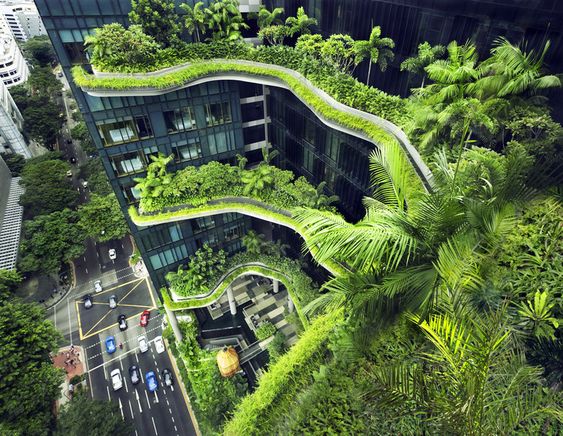
Unlike traditional buildings, which often consume high amounts of energy and generate waste, green apartment building focus on sustainability at every stage of their lifecycle, from construction to daily operation. They aim to balance environmental responsibility, economic efficiency, and human well-being.
Key features of a green building include:
- Energy efficiency through smart design, insulation, and renewable energy use.
- Water conservation with low-flow fixtures, rainwater harvesting, and recycling systems.
- Use of eco-friendly and recyclable materials.
- Improved indoor air quality and natural lighting.
- Waste reduction during construction and operation.
In short, a green building is more than just a physical structure. It is a modern approach towards green building and sustainability, reduces long-term costs, and promotes healthier living and working environments.
The Evolution and History of Green Buildings
Architecture has always reflected the way humans interact with their environment. From ancient times to modern cities, the principles of sustainability have shaped how we design and build spaces.
Ancient Foundations
Sustainable architecture is not a new idea. Ancient builders worked closely with nature, using local materials such as mud, stone, and timber. Designs were simple yet effective, keeping homes comfortable without modern technology. Common features included:
- Thick walls for natural insulation.
- Courtyards to allow airflow and light.
- Wind catchers and green roofs for cooling.
- Passive solar design to regulate temperature.
These methods showed an early understanding of environmental harmony.
The 1970s: A Modern Awakening
The global energy crises of the 1970s sparked a shift in thinking. Rising fuel costs and growing awareness of pollution forced architects to explore energy-efficient designs. The focus turned to reducing dependence on non-renewable energy and lowering the environmental footprint of buildings.
The 1980s: Defining Sustainability
In the 1980s, the Brundtland Commission introduced the concept of sustainable development, meeting present needs without compromising the ability of future generations. This definition became the guiding principle for sustainable architecture.

Buildings were no longer judged only by cost or function, but also by their impact on the environment and human health.
The 1990s: Green Building Standards Emerge
The 1990s marked the formalization of sustainability in construction. Important milestones included:
- 1990: The UK launched BREEAM, the first global green building rating system.
- 1993: The U.S. Green Building Council (USGBC) was established.
- 1998: The LEED certification system was introduced, becoming a worldwide benchmark for green design.
These systems encouraged builders to use eco-friendly and sustainable green building materials, conserve resources, and prioritize occupant well-being.
The Present: Expanding the Vision
Today, sustainable architecture goes beyond individual structures. Entire communities and cities are designed with eco-friendly principles. Modern practices integrate advanced technologies and nature-based solutions, such as:
- Solar panels and renewable energy systems.
- Smart building automation and energy modeling.
- Vertical gardens, green roofs, and natural ventilation.
- Water-saving systems like rainwater harvesting and greywater recycling.
Governments, developers, and individuals now recognize that sustainable design brings long-term economic, social, and environmental benefits.
The Future: Toward Climate-Resilient Cities
The next phase of sustainable architecture aims to create carbon-neutral and climate-resilient cities. Future designs will combine artificial intelligence, renewable technologies, and bio-based materials to build smarter and healthier spaces.
7 Essential Green Building Elements
Although the term green building has become very popular in recent years, the main question is what makes a building green.
Green buildings work because many parts come together. Components of green building reduces impact and improves comfort. Below are the seven essentials, kept simple but complete.
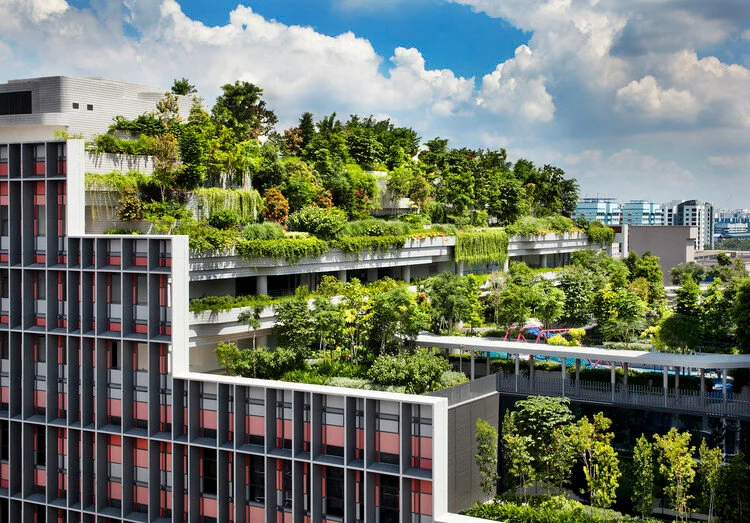
1) Energy Efficiency & Renewables
A green building starts with a tight envelope and smart systems. Good insulation, high-performance glazing, and air sealing reduce heat loss and gain. Efficient lighting and right-sized HVAC cut demand. Add renewables most commonly rooftop solar—to replace fossil energy.
- Typical tools: insulation upgrades, LED lighting, variable-speed drives, solar PV.
2) Water Efficiency & Stormwater Management
Use less water indoors and manage rain outdoors. Low-flow fixtures, leak detection, and greywater reuse trim indoor use. Rainwater harvesting and permeable surfaces reduce runoff and support landscaping.
- Quick wins: low-flow taps and toilets, rain tanks, drip irrigation, permeable paving.
3) Low-Impact, Durable Materials
Choose materials with low embodied carbon and long life. Recycled steel, certified wood, and bio-based options reduce impacts. Specify low-VOC finishes for health. When possible, verify with EPDs and prefer local supply to cut transport emissions.
- Examples often used: recycled steel, bamboo, low-carbon concrete, low-VOC paints.
4) Indoor Environmental Quality (IEQ)
Healthy interiors are central to green design. Provide ample fresh air, filter particulates, and control humidity. Daylight and views support well-being; acoustic and thermal comfort reduce stress and boost productivity.
- Focus areas: ventilation rates, filtration, daylighting, low-emitting materials.
5) Site & Ecology (Location, Orientation, Biodiversity)
Pick sites that cut travel and protect nature. Proximity to transit reduces car use. Orient the building for sun and wind to support passive heating and cooling. Use green roofs and native planting to limit heat-island effects and support urban ecology.
- Tactics: transit-served sites, solar-aware massing, green roofs, habitat planting.
6) Construction & Operational Waste Reduction (Circularity)
Design to use fewer materials and generate less waste. Plan for off-site prefabrication where it helps. Reuse and recycle construction debris. In operation, separate waste streams and compost organics where feasible. Durable, adaptable design extends building life and avoids future waste.
7) Smart Operations, Codes & Continuous Performance
What gets measured gets managed. Use building management systems and sensors to monitor energy, water, and IAQ. Commission systems at handover and re-commission periodically. Align with energy codes and voluntary rating systems to keep performance on track over time.
- Tools: BMS/IoT, fault detection, ongoing commissioning, code and rating compliance.
Green Building Materials
The choice of materials plays a crucial role in making a building sustainable. Traditional construction often relies on resource-intensive products like cement and steel, which carry high environmental costs. In contrast, green building materials are selected for their low impact, durability, and contribution to healthier indoor environments. They not only reduce the carbon footprint of construction but also improve long-term performance.
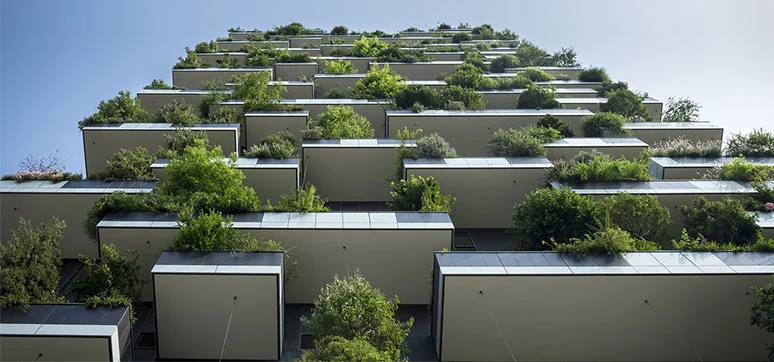
Characteristics of Green Materials
Sustainable building materials share certain qualities that make them better for the environment and people:
- Low embodied energy: Produced with minimal energy use and emissions.
- Renewable or recyclable: Either come from renewable sources or can be reused at the end of life.
- Non-toxic: Free from harmful chemicals and volatile organic compounds (VOCs).
- Durability: Long lifespan reduces replacement needs and waste.
- Local availability: Minimizes transport emissions and supports regional economies.
Commonly Used Green Building Materials
Several eco-friendly materials are now being widely used in both residential and commercial projects:
- Bamboo: A rapidly renewable resource that is stronger than many types of wood and ideal for flooring, walls, and furniture.
- Recycled steel: Provides strength like conventional steel but with significantly lower environmental impact.
- Fly ash and slag cement: Industrial by-products used as partial replacements for Portland cement, reducing carbon emissions.
- Reclaimed wood: Offers character and reduces the demand for new lumber.
- Low-VOC paints and finishes: Improve indoor air quality while providing durability.
- Insulating concrete forms (ICFs): Reduce energy loss and provide strong structural performance.
- Unfired clay bricks and hollow blocks: Require less energy to produce and provide natural insulation.
Pros and Cons of Green Buildings
Following are some of the advantages and disadvantages of green building.
| Pros | Cons |
| Energy efficiency – Reduced electricity demand through insulation, efficient lighting, and renewable energy use. | Higher upfront costs – Sustainable materials, advanced systems, and certifications increase initial investment. |
| Water conservation – Low-flow fixtures, rainwater harvesting, and greywater recycling save significant water. | Limited material availability – Eco-friendly or certified materials may not be accessible in every market. |
| Lower operating costs – Utility bills drop over time due to energy and water savings. | Skilled labor required – Construction teams often need special training in green methods. |
| Healthier indoor spaces – Better air quality, daylight access, and non-toxic materials enhance well-being. | Longer approval and certification timelines – LEED, BREEAM, or other certifications demand extra documentation and time. |
| Reduced environmental footprint – Lower carbon emissions, waste reduction, and efficient resource use. | Maintenance complexity – Smart systems and eco-technologies can require specialized upkeep. |
| Higher property value – Certified green buildings attract premium tenants and buyers. | Delayed ROI – Savings accumulate slowly, so the full return on investment may take years. |
| Future-ready and resilient – Prepared for stricter codes, climate change, and energy challenges. | Perception barriers – Some stakeholders still view green buildings as expensive or experimental. |
Global Standards & Certification Frameworks
Green buildings are measured and validated through recognized certification systems and codes. These frameworks ensure that sustainability is not just a design choice but a measurable performance standard. Below are the key global benchmarks shaping the future of green construction.
LEED: The Global Benchmark
The Leadership in Energy and Environmental Design (LEED) system, developed by the U.S. Green Building Council (USGBC), is the most widely used green building certification. It evaluates projects across several categories:
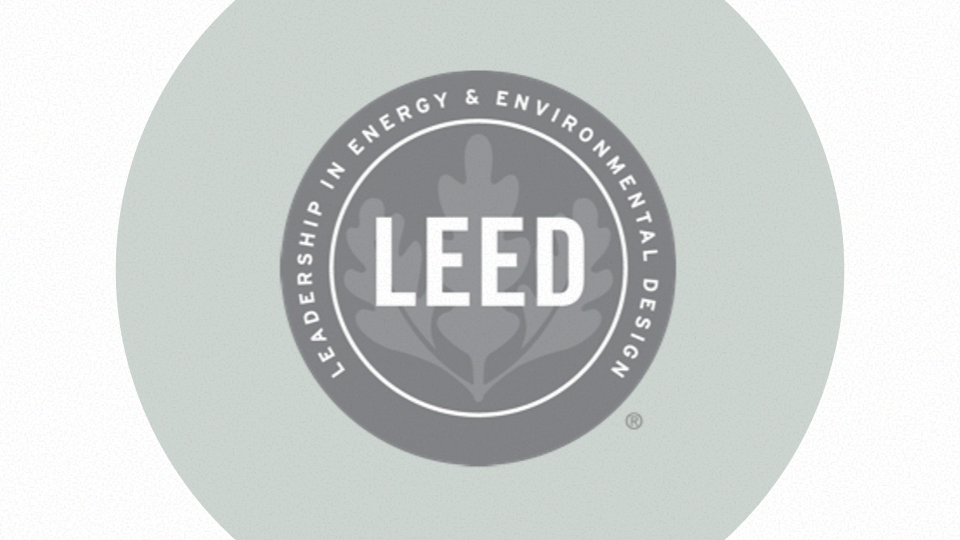
- Energy performance and renewable energy use
- Water efficiency in green buildings with conservation and recycling measures
- Indoor environmental quality for health and comfort
- Materials and resources emphasizing eco-friendly and recycled products
LEED awards four levels of certification, Certified, Silver, Gold, and Platinum, based on the number of points earned. Its global recognition makes it the benchmark for offices, schools, hospitals, and community-scale projects.
BREEAM and Green Globes
The Building Research Establishment Environmental Assessment Method (BREEAM), launched in the UK in 1990, is the oldest green building certification system. It assesses:
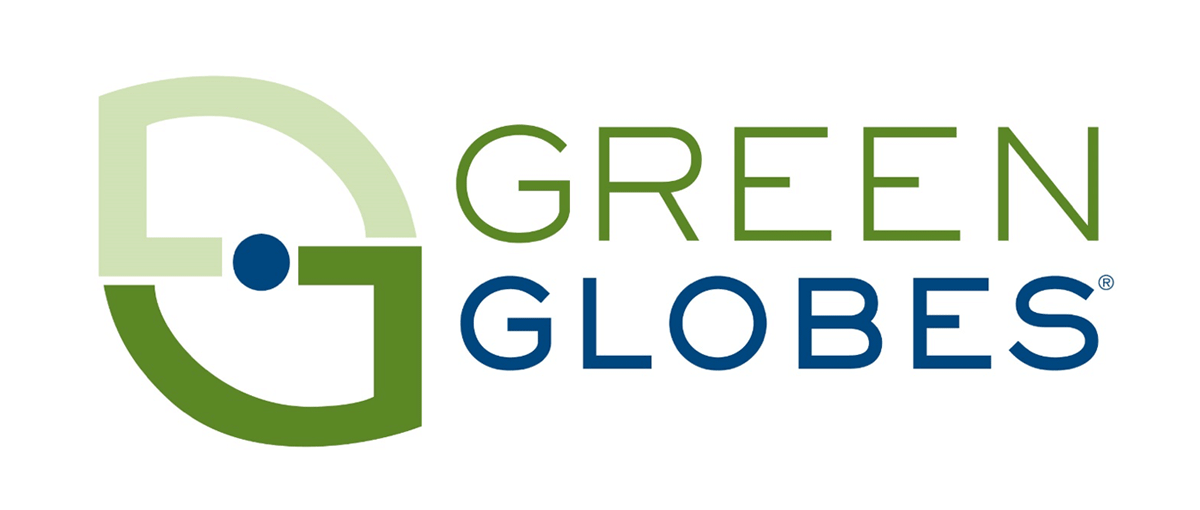
- Management and operations
- Energy, water, and waste performance
- Transport and materials use
- Health, well-being, and ecological impact
In North America, Green Globes serves as a flexible and cost-effective alternative to LEED. Its key features include:
- Online questionnaires and simplified assessment tools
- Third-party verification for credibility
- Practical pathways for small- and mid-scale projects
Both BREEAM and Green Globes remain influential in setting sustainability standards across regions.
GRESB: Benchmarking for Investors
The Global Real Estate Sustainability Benchmark (GRESB) focuses on investment portfolios rather than individual buildings. It measures:
- Environmental performance across property portfolios
- Social impact and community engagement
- Governance practices for accountability and transparency
GRESB provides investors with data to compare sustainability across funds and companies, making it a critical tool for green finance and ESG reporting.
National Building Codes and Incentives
Governments also drive sustainability by setting mandatory codes and offering incentives. Over 80 countries now enforce building codes focused on energy efficiency and environmental standards. These often include:
- Minimum efficiency requirements for energy and water use
- Climate-adapted codes suited to local conditions
- Financial incentives such as tax breaks, grants, or fast-track permits
These measures ensure that green building practices scale beyond voluntary certifications and become part of everyday construction.
Why Certification Matters?
Certification and standards provide more than recognition. They deliver:
- Guidance for architects and builders
- Marketability and higher property value for developers
- Credibility and trust for tenants and investors
Continuous improvement by pushing innovation in design and technology
Green Building Success Stories in Pakistan
Pakistan has begun embracing sustainable architecture, with several projects standing out as pioneers in eco-friendly construction. These buildings prove that sustainable design is possible in developing economies, where energy shortages and climate challenges are pressing concerns.
The Arfa Software Technology Park, Lahore
One of the earliest large-scale sustainable buildings in Pakistan, this IT hub integrates modern design with efficiency measures.
- Energy-efficient HVAC systems reduce operational costs.
- Natural light optimization lowers electricity demand.
- Rainwater harvesting contributes to water conservation.
The Aga Khan University Hospital, Karachi
Healthcare facilities are among the most resource-intensive buildings, but this hospital has adopted green practices.
- Uses efficient lighting and smart energy management systems.
- Incorporates waste management strategies to minimize hospital-generated waste.
- Focus on patient well-being through natural ventilation and improved indoor air quality.
Packages Mall, Lahore
This commercial complex is one of the country’s largest malls, designed with sustainable elements in mind.
- Incorporates energy-efficient lighting and centralized HVAC.
- Waste management systems segregate and recycle materials.
- Stormwater and rainwater management reduce environmental strain.
The Nishat Hotel, Lahore
Hospitality projects are energy-intensive, but the Nishat Hotel demonstrates a shift toward eco-conscious design.
- Smart building systems for energy monitoring.
- Efficient water usage with low-flow fixtures.
- Green materials used in interiors to improve sustainability.
UBL Tower, Karachi
The headquarters of United Bank Limited is among the most modern green towers in the country.
- High-performance glass façade minimizes heat gain.
- Efficient elevators and building automation systems reduce energy waste.
- Designed to meet international sustainability standards for corporate towers.
Emporium Mall, Lahore
Another major retail complex that has integrated sustainable technologies.
- Centralized waste management system for recycling and disposal.
- Energy-efficient cooling and heating systems.
- Designed to maximize daylight use while reducing heat load.
Why These Projects Matter?
These examples show that Pakistan is taking steps toward sustainable construction, even in energy-hungry sectors like IT, healthcare, retail, and hospitality. Each project demonstrates:
- Lower operational costs through energy and water efficiency.
- Healthier spaces that prioritize human comfort.
- Environmental responsibility by reducing carbon footprints.
Benefits & ROI of Going Green
Investing in green buildings is not just an environmental choice—it is also a smart financial and social decision. Sustainable construction delivers measurable savings, healthier living conditions, and long-term economic returns. These benefits make green design attractive for homeowners, businesses, and investors alike.
Energy and Water Savings
One of the most tangible benefits of green buildings is the reduction in utility bills. By using energy-efficient systems and water-saving technologies, buildings consume fewer resources without compromising comfort.
-
On average, green buildings use about 25% less energy and 11% less water compared to traditional structures.
-
High-performance insulation, efficient lighting, and renewable energy systems lower electricity demand.
-
Rainwater harvesting, low-flow fixtures, and greywater recycling help conserve water and reduce operating costs.
These savings quickly add up, providing a clear return on investment within just a few years.
Health and Productivity Benefits
Green buildings are designed with people in mind, not just structures. By focusing on indoor environmental quality, they create healthier and more productive spaces.
-
Improved air quality through natural ventilation and low-emission materials reduces respiratory issues.
-
Access to natural light boosts mood, focus, and productivity for occupants.
-
Comfortable thermal and acoustic conditions reduce stress and improve overall well-being.
Studies show that businesses operating in green-certified spaces often report higher employee satisfaction and reduced absenteeism.
Long-Term Economic Advantages of Green Building
Beyond immediate utility savings, green buildings offer significant long-term financial returns.
-
Properties with green certifications often have higher market value and attract premium tenants.
-
Lower operational costs improve net operating income, making them more appealing to investors.
-
Many governments offer incentives, tax breaks, or grants for sustainable construction, further improving ROI.
Enhanced Marketability and Reputation
In today’s competitive real estate market, sustainability is a selling point. Buildings that are energy-efficient and environmentally responsible are easier to market and often lease or sell faster. They also strengthen a company’s brand image, signaling responsibility and innovation to clients, employees, and stakeholders.
Innovative Technologies & the Future of Green Buildings
The future of green buildings lies in innovation. As cities grow and environmental pressures intensify, sustainable design is moving beyond basic efficiency to embrace advanced technologies and creative solutions. These innovations not only improve building performance but also redefine how we interact with our spaces.
Eco-Innovations in Design
Modern green buildings integrate natural systems into their structures, creating healthier and more sustainable environments.
- Green walls and vertical gardens improve air quality, regulate indoor temperatures, and enhance aesthetics.
- Hydroponic gardens inside or on rooftops provide fresh produce while reducing food miles.
- LED lighting systems drastically cut energy use while offering longer lifespans and better illumination.
Such eco-innovations connect occupants with nature while reducing the ecological footprint of buildings.
Smart Integration and Digital Tools
Technology is revolutionizing how buildings are designed and managed. Smart systems ensure real-time monitoring and optimization of resources.
- IoT sensors track energy, water, and air quality, allowing automated adjustments.
- AI-driven energy optimization predicts usage patterns and reduces waste.
- Climate-responsive designs adapt building operations to changing weather, ensuring comfort with minimal energy input.
These tools create “intelligent buildings” that learn from data, becoming more efficient over time.
Tackling Global Challenges
Future green buildings must address broader challenges linked to urbanization and climate change.
- Urban density: High-rise sustainable towers with shared resources can house more people while minimizing land use.
- Climate change: Buildings designed to withstand floods, heatwaves, and extreme weather will ensure long-term resilience.
- Resource scarcity: Innovations like greywater recycling, modular construction, and bio-based materials reduce pressure on natural resources.
How to Build or Retrofit Green
Creating a green building does not always require starting from scratch. Whether constructing a new project or upgrading an existing one, the process involves a series of steps that ensure sustainability, efficiency, and long-term performance. These steps guide developers, architects, and building owners through practical choices that make a lasting difference.
Sustainable Site Selection and Passive Design
The journey begins with choosing the right location and layout. A carefully selected site reduces environmental disruption and improves efficiency. Passive design strategies also lower long-term energy demand.
- Sites close to public transport reduce car dependency.
- Building orientation, shading, and natural ventilation cut heating and cooling needs.
- Preserving landscapes and biodiversity supports ecological balance.
Energy Modeling and Performance Goals
Energy modeling helps predict a building’s consumption before construction begins. It allows teams to set clear, measurable targets.
- Simulations reveal heating, cooling, and lighting requirements.
- Performance goals guide design decisions and encourage renewable integration.
- Adding systems like solar panels or geothermal heating early ensures better efficiency.
Material Selection for Impact and Recyclability
The choice of materials defines both the immediate and long-term environmental footprint of a building.
- Locally sourced and recyclable materials reduce transport emissions.
- Low-VOC paints and adhesives create healthier indoor spaces.
- Durable options like bamboo, recycled steel, or engineered wood extend building life.
Water Management and Waste Reduction
Conserving water and reducing waste are central to green design. Both construction and operation benefit from smart strategies.
- Low-flow fixtures and dual-flush toilets minimize water use.
- Rainwater harvesting and greywater recycling reduce pressure on municipal supplies.
- Recycling and repurposing construction debris lowers landfill waste.
Certification and Code Compliance
Certification frameworks and building codes ensure credibility and accountability. They also add long-term value to projects.
- Systems like LEED, BREEAM, or Green Globes provide global recognition.
- Local energy codes guarantee compliance with regional standards.
- Government incentives reward projects that exceed efficiency targets.
Smart Systems and Post-Occupancy Evaluation
A building’s sustainability journey continues after occupancy. Smart systems and evaluations ensure performance remains consistent over time.
- Building Management Systems (BMS) monitor energy and water use in real time.
- IoT sensors track indoor air quality and optimize HVAC systems.
- Post-occupancy evaluations confirm design goals and highlight areas for improvement.
Conclusion
The importance of green building materials can not be denied.They are a necessity for a sustainable future. By combining energy efficiency, water conservation, sustainable materials, and smart technologies, they reduce costs, protect the environment, and improve human well-being.
The journey of sustainable architecture, from ancient climate-responsive designs to modern smart buildings, shows how innovation and responsibility can go hand in hand. With global certifications like LEED and BREEAM, as well as local initiatives, green design has become a benchmark for quality and resilience.
For Pakistan and other developing countries, adopting green building practices means more than lowering bills. It means building healthier cities, creating long-term economic value, and addressing challenges like climate change and resource scarcity.
The future of construction is clear: smarter, greener, and healthier spaces that benefit both people and the planet. Choosing to build or retrofit green is not just an investment in property—it is an investment in a sustainable tomorrow.
For more informational blogs like Impacts of climate change in Pakistan, visit Chakor blogs.

